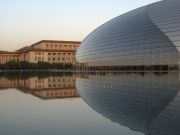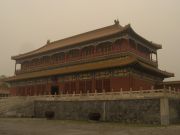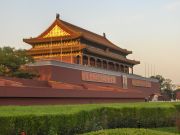| The City of Beijing was country capital for eight times. None of them changed it as much as the current period, when it is serving as the capital of People´s Republic of China. |

Dec 2011 |
|
 |
 |
 |
 |
 |
 |
 |
 |
The new Opera and the seat of the Party
 |
 |
The earliest recorded settlements of Beijing date from 1045 BC according to in Chinese historical sources. Its importance started in 1215, when Ghenghis Khan captured the city (although back then the city was already enclosed within fortified walls). He burned it, rebuilt it from ashes and called it Dadu (also assuming Mongol name Khanbalik). The Mongol invasion transformed the city into a powerful national capital, a status that it enjoys to the present day. The last power transfer was in 1949, when the Communist Party took power. From this moment on, Beijing changed more than what it had changed during the last 700 years. This is not the place to judge, but the truth is that the different campaigns launched by Mao and The Cultural Revolution stripped the city from its cultural heritage. Many buildings, palaces and temples were destroyed or abandoned, books were burned, everything old and ancient was considered bad and disappeared. Even the massive city walls from 1435 were dismantled to build The Ring Road 2. There are few places left where hutongs (typical area of narrow streets or alleys, most commonly know in Beijing) survived. At a certain point, the government noticed that the ancient buildings could be a source of money. Thos that survived are under renovation.
Currently, the city is home to around 19.5 million people, most of them belonging to Han ethnicity. Uncontrolled development is the reason of heavy air pollution. During my stay there, it was only after rain that we had a good visibility. To upgrade the quality of the air during the Olympic Games, most of the factories were closed down. Despite the long distances, it is quite easy to navigate in the city. There are 14 lines of subway and all stations are marked in Chinese and English. Beijing is a hub for local transport, although it is not easy to buy the ticket (on the main train station, destinations were marked only in Chinese).
However, in spite of everything, the city can be very charming.
|
|
| Favourite spots: |
 |
 |
 |
 |
 |
 |
 |
 |
The Forbidden City in a very bad weather
 |
 |
The Forbidden City (Zijn Cheng) is one of China’s highlights. It was the Imperial Palace of Ming and Quing Dynasties. The fact that ordinary people could not enter nicknamed the place. Built from 1406 to 1420, it contains 980 buildings, 8.706 halls and rooms and around 720.000 square meters. It served for 500 years as a home for 24 emperors and their households. From 8 to 10 thousand people could live there in the same moment.
Surrounded by the moat and by massive walls, the Forbidden City has two main entrance gates – the Divine Military Genius Gate and the Meridian Gate.
The layout of the buildings is in line with the old Chinese scheme: built in an axle north – south, with the entrances to the south (since from the north only cold winds and barbarians were coming). The Hall of Supreme Harmony is the most significant, where the important ceremonies were held. It is a striking building in the middle of a huge courtyard.
|
|
| What's really great: |
It is not possible to see even half of the temples in Beijing when you have only a few days. For me, one of the greatest ones were:
- Lama Temple (a.k.a. Yonghe Temple), built in 1694 as an official residence for court eunuchs, luckily survived the Cultural Revolution without being destroyed. The temple has beautiful frescoes. The Pavilion of Ten Thousand Happinesses stores a 26 m high statue of Buddha, carved from one piece of white sandalwood.
- Confucious Temple is the second biggest Temple dedicated to Confucious in China, after one located in his hometown, Qufu. The complex was built in 1306 and, until 1911, it was the main worship place for the officials.
- Niujie Mosque - this is a wonderful example of Islamic architecture in Beijing. It was built in 996 by the Arabian scholar Nasurutan. Its 6.000 square meters contain a hall of worship, minaret, lecture hall, a stele pavilion and an ablution chamber. Niujie Mosque undergone complete renovation in 1979.
|
|
| Sights: |
The Great Wall of China is one of the new seven wonders of the world. It was built more than 2 000 years ago, but acquired its present shape during the Ming Dynasty. It has more than 8.000 kilometres long and stretches from Shanhaiguan (the bay in the Yellow Sea) in the east to the Lop Lake in the west. During the Ming era, millions of workers died, as the working conditions were extremely hard. During Mao's time, there was a rumour that the wall was the only human construction that could be seen from the moon.
It is easily reachable from Beijing. There are a few places where tourists can enter to The Great Wall. The best well known is in Badaling, other spots are Mutiyanu and Jinshanling. Since I did not want to be swallowed by a horde of tourists, I chose the least popular spot, in Jinshanling. The trek between Jinshanling and Simatai is more than 10 km long, has 5 passes and 65 towers. It is better to have good shoes, given that many sections are in a very bad condition.
|
|
| Accommodations: |
 |
 |
 |
 |
 |
 |
 |
 |
The gate on Tianaman Square
 |
 |
I stayed in the Peking International Youth Hostel, a very nice place with a good location next to the Forbidden City. But, as Beijing was the host city for the Olympic games, it should not be a problem to find accommodation. The only question is how much you are ready to pay. Because the city is huge, it is a clever idea to choose accommodation near one of the many subway lines. Many places offer travel services, other than lodging. Sometimes, it may even be better to use their services (if you don't have much time). I went to see The Great Wall on an organized trip and I was happy with the level of services provided by my hostel.
|
|
| Nightlife: |
The Summer Palace with The Imperial Gardens are among the biggest attractions and are located 16 km from Beijing city's centre. The first palace was built here in XII century, rebuilt in XVIII century by the Emperor Quianlong and, after the destruction caused by the Opium Wars, by Empress Cixi (she used all the money earmarked for a modern navy). Now it is a huge complex located around Kunming Lake with the wonderful Foxiangge Pagoda on the top of Wanshou Shan. Unfortunately, I visited the Summer Palace during public holidays, so it was extremely crowded. I had no chance to see all the wonders quietly. Interesting thing to see there is The Marble Boat, a place where the Empress Cixi was having tea.
The Temple of Heaven is the place where, according to local beliefs, the middle of the world is located. It is a complex of Taoist buildings dated from 1406 to 1420 and built by Yongle Emperor. The most wonderful buildings are The Hall of Prayer for Good Harvest the Imperial Vault of Heave
|
|
| Hangouts: |
|
For ages, the people of Beijing were protected by the Great Wall or by the massive chain of the city walls (destroyed in the 50's to built up the Ring Road). But they also created their own labyrinth of narrow alleys and walls. That was how the hutongs appeared in Beijing. It was the spot where family life concentrated. Each courtyard had a well, flowers, trees and a wall against unfriendly ghosts. Wooden gates were always decorated with sentences, to bring luck and happiness for the family. When the communist decided that having only one family in such houses was a bourgeois habit, they forced several families to live in the same house. The future is not bright for the hutongs: they are disappearing quickly, giving place to new streets, commercial centres and other constructions. However, the ones that are left are a charming example of the old Chinese way of living. I had the chance to see two hutongs: one was freshly rebuilt and the other one was an original.
|
|
| Restaurants: |
|
Chinese food could be a separate story. A great diversity and the size of the country are the main reasons for a great variety. In Beijing, there is a chance to find specialities from the entire country. An entire range of restaurants can be found: from the most expensive ones to small family-run places or street eateries. Some might be not particularly clean, but the food is excellent everywhere. The best I had was in a restaurant near Cow Street Mosque: nobody spoke English and my food glossary in the guidebook didn't help as well. So, I pointed to the waitress some dish on the neighbouring tables and I got my tasty sweet and sour chicken (I hope). The steamed dumplings with meat were also a delicacy. Another interesting place was in Wangfujing street. Dozens of stand offer the strangest food, like scorpions, snakes, grasshoppers, kidneys, squids, cicadas, woodlouses, etc. All you can eat and all you are brave enough to eat. I tried only some snake meat, but I went back to dumplings.
|
|
| Other recommendations: |
|
Spending some spare time in one of the many Beijing parks can be a great idea. Not only because of the great buildings, but also to see how local people spend their free time. I was in Ditan Park on a Sunday morning and I was amazed. Just after the entrance, I saw people doing many different activities, like: dancing, singing, tai chi classes, ladies playing with ribbons, Chinese chess matches, while others were playing on some intriguing music instruments. Everybody seemed to be relaxed and enjoying what they were doing. The positive surprise was the fact that it was not for tourists. They just enjoyed life in such way. Not only Sunday activities are held outside. If one needs a haircut or a dentist, one can easily have those on the streets. My advice for the travellers is to avoid tourist attractions during the weekends. They are completely crowded and it is just impossible to see anything quietly or without spending hours in the queues.
|
|
Published on Monday December 26th, 2011
|
|
 Publish on Facebook
Publish on Facebook
|
Wed, May 02 2012 - 01:55 PM
 by bootlegga
| An excellent report on Beijing - congrats on the RoM! |
Tue, Jan 17 2012 - 06:55 PM
 by horourke by horourke
Just stunning. A work of extraordinary scholarship in the historical analysis as well as very great practical detail of current functions and facilities.
I have some interest in China but do not expect to go there . Your report brings it a little nearer. |
Mon, Jan 16 2012 - 07:59 PM
 by jacko1 by jacko1
| I never tire of reading your excellent, well written and researched reports, wikipedia is less well informed than yourself, I was not allowed to award 10 stars but this is my valuation! Thankyou, Tony. |
Mon, Jan 16 2012 - 09:28 AM
 by pesu by pesu
| Rafal, finally I've made it to read your great Beijing report! Let me congratulate on winning RoM - it's really well-deserved! I admire your proficiency to write such a long text in a foreign language and the photos are brilliant! Thanks for sharing! :) |
Tue, Dec 27 2011 - 02:19 PM
 by krisek by krisek
| Very nicely written indeed, and the pictures are great. I echo Wojtek! |
Mon, Dec 26 2011 - 02:01 PM
 by wojtekd by wojtekd
| Great report about the giant city. ROM candidate I think... |
| Information: |
| Login if you are a member, or sign up for a free membership to rate this report and to earn globo points! |
|
| Bolivia |
|
|
 |
| Cambodia |
|
|
 |
| Chile |
|
|
 |
| China |
|
|
 |
| Czech Republic |
|
|
 |
| France |
|
|
|
|
|
|
|
|
 |
| Hungary |
|
|
 |
| Lithuania |
|
|
 |
| Macedonia |
|
|
 |
| Portugal |
|
|
|

|
